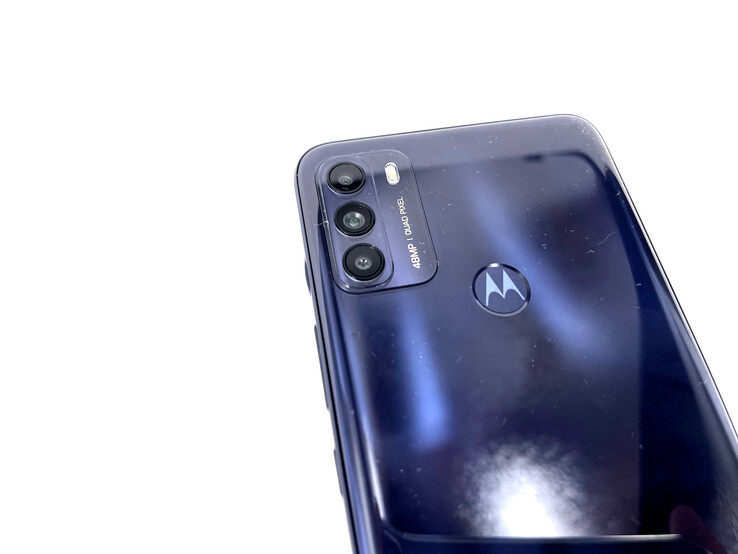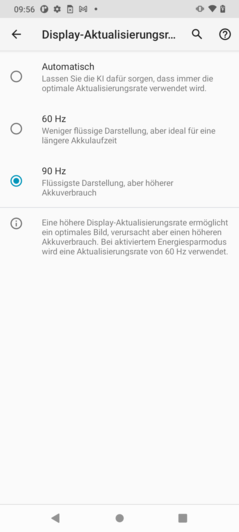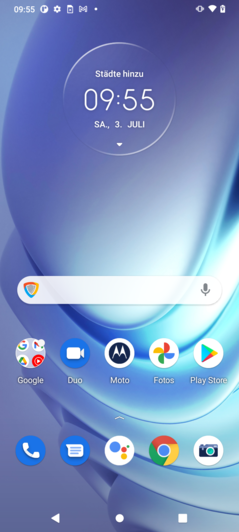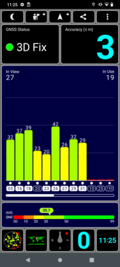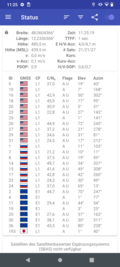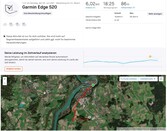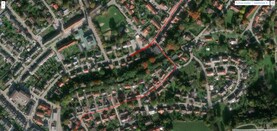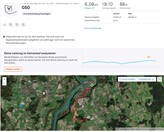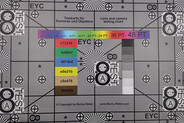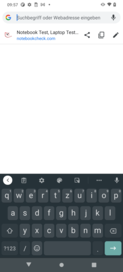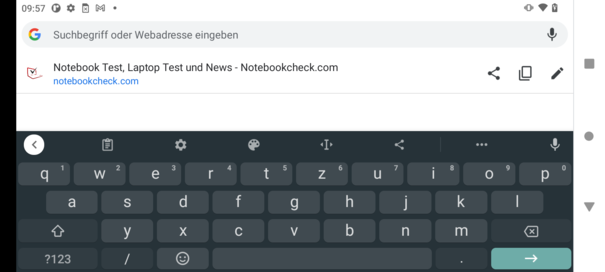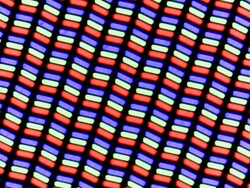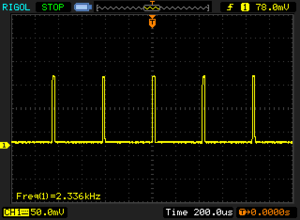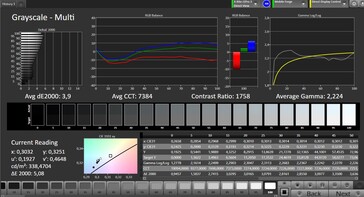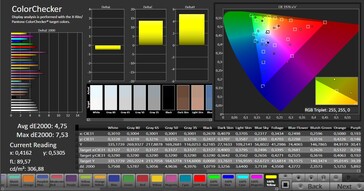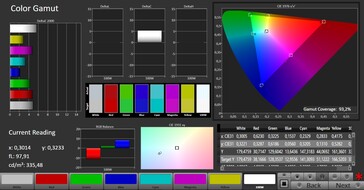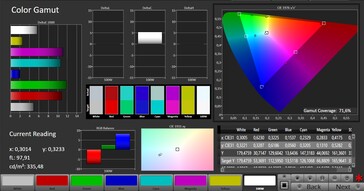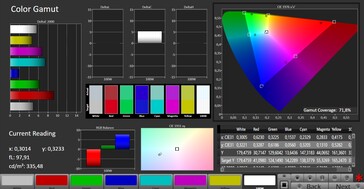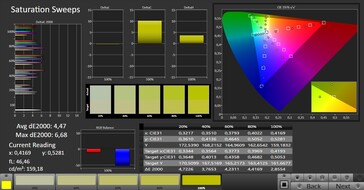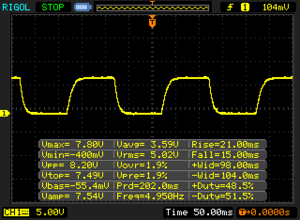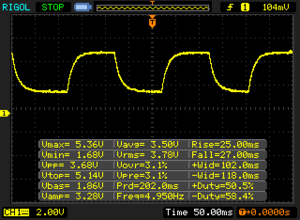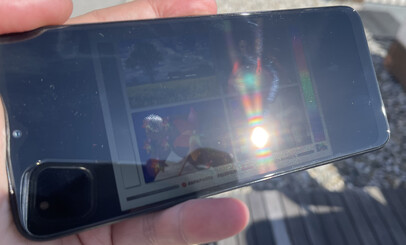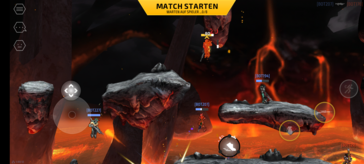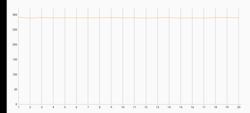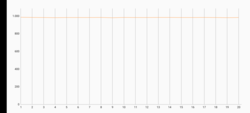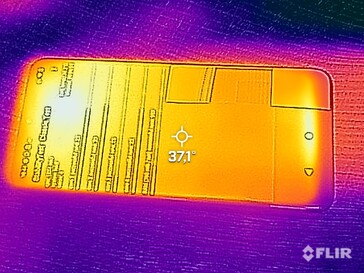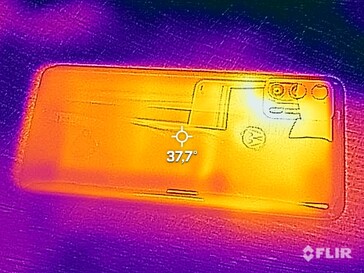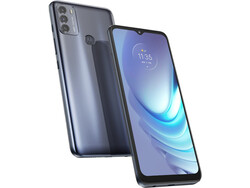Motorola Moto G50 smartphone review: 5G mid-range phone with 90 Hz display
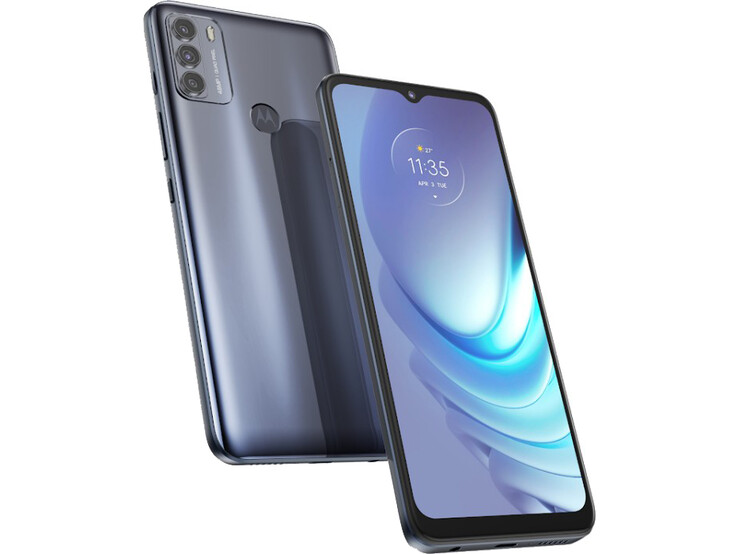
The second fastest and second most expensive new member of the Moto G family goes by the name of Moto G50. Like the Moto G100, the mid-range smartphone features 5G and a 90 Hz display, but it's considerably slower, and the 250-Euro (~$295) price difference is also noticeable in terms of features.
Nevertheless, it could be a good offer compared with similarly priced smartphones, since you also get a fairly pure Android OS and a large battery.
Possible contenders in comparison
Rating | Date | Model | Weight | Drive | Size | Resolution | Price |
|---|---|---|---|---|---|---|---|
| 79.2 % v7 (old) | 07 / 2021 | Motorola Moto G50 SD 480, Adreno 619 | 192 g | 64 GB UFS 2.1 Flash | 6.50" | 1600x720 | |
| 85.4 % v7 (old) | 05 / 2021 | Motorola Moto G100 SD 870, Adreno 650 | 207 g | 128 GB UFS 3.1 Flash | 6.70" | 2520x1080 | |
| 79.3 % v7 (old) | 03 / 2021 | Samsung Galaxy A32 5G Dimensity 720, Mali-G57 MP3 | 205 g | 64 GB UFS 2.1 Flash | 6.50" | 1600x720 | |
| 84.6 % v7 (old) | 05 / 2021 | Xiaomi Poco X3 Pro SD 860, Adreno 640 | 215 g | 128 GB UFS 3.1 Flash | 6.67" | 2400x1080 | |
| 81.1 % v7 (old) | 06 / 2021 | Xiaomi Redmi Note 10S Helio G95, Mali-G76 MP4 | 178.8 g | 128 GB UFS 2.2 Flash | 6.43" | 2400x1080 |
Case – Moto without Gorilla Glass?
The Motorola Moto G50 is mostly made of plastic on the outside. The blue-gray or dark green back reflects and refracts light in its deeper layers, resulting in nice light effects. The camera module itself already protrudes slightly from the case, and the lenses are raised further. We would have preferred a homogeneous surface structure in terms of feel here, and the camera module visually appears a bit like it was added later as well. However, that is naturally a matter of taste.
A fingerprint sensor with an integrated Motorola logo is also located on the back.
Motorola doesn't provide any information regarding the use of Gorilla Glass on the front. It could be that the manufacturer does use Gorilla Glass but hasn't acquired the license, so that it's not allowed to do any advertising with it; or it could also be the case that it's a simpler display glass. Either way, the protection against a broken display glass can only be assessed poorly compared with other smartphones in the price range.
The smartphone has a sturdy build. The Moto G50 is hardly affected by pressure, even when applied to the screen. The specified IP52 protection indicates dust resistance and protection against splashing water.
Connectivity – Dual SIM and USB-C
The Moto G50 comes with 4 GB of RAM, and you can also choose whether you want 64 GB of mass storage or 128 GB. Two SIM cards can be used in the smartphone, or you can replace one of the two cards with a microSD card to expand storage.
A modern USB-C port is available, but it's only connected internally with USB 2.0 speeds.
microSD card reader
Overall, the card reader is a bit slower than in comparable devices.
| SD Card Reader - average JPG Copy Test (av. of 3 runs) | |
| Xiaomi Redmi Note 10S (Toshiba Exceria Pro M501) | |
| Xiaomi Poco X3 Pro (Toshiba Exceria Pro M501) | |
| Motorola Moto G20 (Angelbird V60) | |
| Motorola Moto G50 (Angelbird V60) | |
Cross Platform Disk Test (CPDT)
Software – Pure Android in the Moto phone
A fairly pure Android 11 is installed on the smartphone. Motorola traditionally doesn't use its own launcher, but it only installs the Moto app for device-specific settings instead. The security patches are at the level of May 2021 and therefore no longer quite up to date.
Users who like to watch HD content on streaming services can do so without any issues, since a DRM Widevine L1 certification is available.
Communication and GNSS – Fast WLAN and NFC
Wi-Fi 5 is the maximum supported standard in the smartphone, which is common in this price range. In our Wi-Fi test with the Netgear Nighthawk AX12 reference router, the Moto G50 is relatively slow but still within the normal range for a device with Wi-Fi 5. You can get considerably faster transfer rates, though, with the Poco X3 Pro, for example.
The Moto G50 offers 5G support, another feature that is almost standard for this price range this year, while the Redmi Note 10S, for example, has to get by only with 4G. In addition, the review sample supports numerous 4G frequencies, so you can also browse the mobile Internet quite reliably when traveling abroad.
Bluetooth 5.0 and NFC are also on board, so you can also use mobile payment services without problems.
Although the Moto G50 doesn't recognize many satellites according to the GPS Test app, it's sufficient for precise positioning: A very good accuracy of 3 meters is already achieved after a few seconds.
In our practical test, a bike ride on which we also take the Garmin Edge 520 as a comparison device, the Moto G50 proves to be fairly accurate in terms of positioning accuracy. However, it's occasionally off track too. If you don't need absolute accuracy, the Moto phone should be a suitable navigation device.
Telephone and call quality – Talking loudly is required
Motorola uses a fairly pure version of Android, so the phone app is also from Google. It's easy to use, and it might also be familiar to some users who have switched from other mobile phone brands, so it's not a bad choice in general. It goes without saying that VoWiFi and VoLTE are on board.
In terms of call quality, we noticed that the internal earpiece has a pretty decent sound, and the voice of person on the other end doesn't overmodulate even at maximum volume. However, we aren't satisfied with the microphone's quality: You have to speak very loudly for your voice to be picked up. The speaker has a rather poor sound in hands-free mode, where voices sound very thin, and once again, the microphone has trouble registering our voice when we speak a bit more quietly.
Cameras – Main camera with pixel-binning
The Motorola smartphone comes with a 48-megapixel lens as its main camera. However, it only takes 12-megapixel photos by default, but in return, it combines each four pixels into one pixel and consequently increases the light yield. The remaining features of the main camera are rather straightforward, but that is not unusual in this price range. What's more annoying is that there is no option for recording 4K videos.
The picture quality is quite decent; bright areas tend to be slightly overexposed and details generally look a bit pixelated, but the camera should be absolutely sufficient for the less demanding photographers. Especially since the macro lens adds a bit of flexibility when you want to take close-ups.
As already mentioned, videos can only be recorded in 1080p and 60 fps with the main camera. Unfortunately, movements are displayed very shakily in the viewfinder; they are smoother in the final video, but you can clearly see how the autofocus is searching for the right sharpness.
The front-facing camera has a resolution of 13 megapixels and takes solid selfies that are still quite sharp even when enlarged.
Image comparison
Choose a scene and navigate within the first image. One click changes the position on touchscreens. One click on the zoomed-in image opens the original in a new window. The first image shows the scaled photograph of the test device.
Main camera - FlowerMain camera - SurroundingsMain camera - Low lightThe image looks very grainy in very low light, but the detail reproduction and the illumination are absolutely fine. At a brightness of only 1 lux, the pictures are still somewhat recognizable.
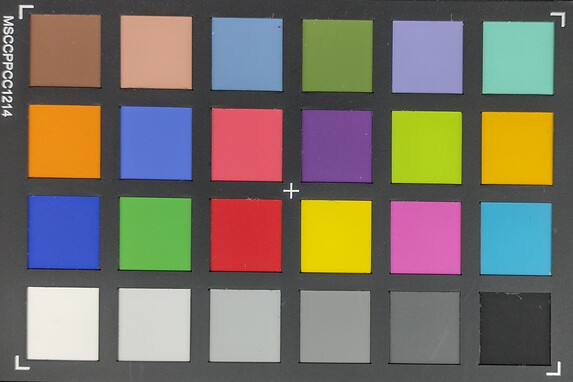
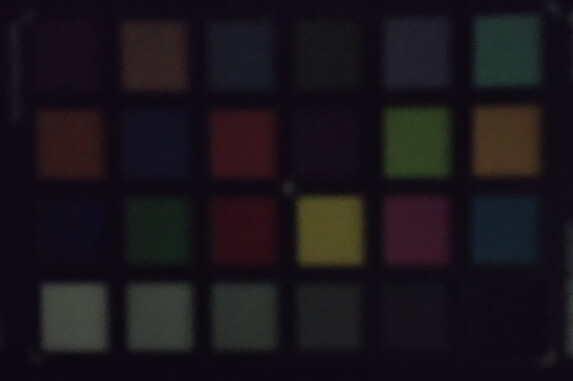
Accessories and warranty – An odd decision
If a manufacturer doesn't include a charger, they're either cheap or environmentally conscious then, since many people have a USB charger at home anyway.
The situation is a bit different for the Motorola Moto G50: Although a charger is included, it only supports charging at 10 watts, even though the smartphone can actually handle 15 watts. The environmental argument doesn't work here, so it can only be because Motorola wants to save money, which we find unfortunate in two respects: Customers will either put up with this and charge their device slower, or they will buy another 15-watt charger, which will leave them with two chargers. Even if buyers already have a 15-watt charger at home, they don't need the included charger, so it's an unnecessary accessory.
We don't know how much the additional purchase price is for a 15-watt power adapter compared to the 10-watt charger. However, we find it an odd decision to include a power adapter that doesn't make use of the phone's capabilities.
Otherwise, the package includes a silicone bumper case, a headset, and a USB cable, of course, as well as a SIM tool. Therefore, an extensive range of accessories is available.
Motorola offers customers in Central Europe a 24-month warranty.
Input devices and handling – Fast operation
The touchscreen can be used smoothly, and the perceived response time is very fast as well thanks to the 90 Hz display. There's a dedicated button for Google Assistant on the right side of the case. Since the volume rocker and power button are directly below it, it takes a while to find the desired button. More clarity would have been nice here.
The fingerprint scanner is found on the back. Fans of clean designs would probably prefer a sensor underneath the screen, but the dedicated scanner works very quickly and unlocks the screen after only a brief delay. The fingerprint recognition is very reliable as well.
Display – Dim screen in the Motorola phone
By no means do all competitors offer a 90 Hz display. However, some of them offer a higher resolution: 1600x720 pixels like in the Moto G50 should slowly become a thing of the past even in this price range. On the other hand, the difference in quality compared to Full HD is visible, but not huge on comparatively small smartphone displays.
A more serious issue for us is that the Moto G50, like the Moto G10 and the Moto G20, fails to convince in terms of display brightness: We measure an average of 324.7 cd/m². That rather sounds like values that were normal a few years ago. Today, we expect better brightness rates especially for outdoor use.
| |||||||||||||||||||||||||
Brightness Distribution: 92 %
Center on Battery: 340 cd/m²
Contrast: 1889:1 (Black: 0.18 cd/m²)
ΔE ColorChecker Calman: 4.75 | ∀{0.5-29.43 Ø4.79}
ΔE Greyscale Calman: 3.9 | ∀{0.09-98 Ø5}
93.2% sRGB (Calman 2D)
Gamma: 2.224
CCT: 7384 K
| Motorola Moto G50 IPS, 1600x720, 6.5" | Motorola Moto G100 IPS/LTPS, 2520x1080, 6.7" | Samsung Galaxy A32 5G TFT-LCD, 1600x720, 6.5" | Xiaomi Poco X3 Pro IPS, 2400x1080, 6.7" | Xiaomi Redmi Note 10S AMOLED, 2400x1080, 6.4" | Motorola Moto G20 IPS, 1600x720, 6.5" | |
|---|---|---|---|---|---|---|
| Screen | -27% | -34% | 8% | 64% | 1% | |
| Brightness middle (cd/m²) | 340 | 562 65% | 543 60% | 567 67% | 706 108% | 389 14% |
| Brightness (cd/m²) | 325 | 535 65% | 512 58% | 524 61% | 701 116% | 352 8% |
| Brightness Distribution (%) | 92 | 90 -2% | 85 -8% | 87 -5% | 98 7% | 83 -10% |
| Black Level * (cd/m²) | 0.18 | 0.57 -217% | 0.63 -250% | 0.57 -217% | 0.29 -61% | |
| Contrast (:1) | 1889 | 986 -48% | 862 -54% | 995 -47% | 1341 -29% | |
| Colorchecker dE 2000 * | 4.75 | 3.99 16% | 4.9 -3% | 1 79% | 2.1 56% | 3.35 29% |
| Colorchecker dE 2000 max. * | 7.53 | 9.74 -29% | 8.6 -14% | 2.1 72% | 4.9 35% | 6.29 16% |
| Greyscale dE 2000 * | 3.9 | 6.5 -67% | 6.3 -62% | 1.7 56% | 1.5 62% | 2.3 41% |
| Gamma | 2.224 99% | 2.174 101% | 2.23 99% | 2.16 102% | 2.29 96% | 2.29 96% |
| CCT | 7384 88% | 6882 94% | 8120 80% | 6343 102% | 6447 101% | 6923 94% |
* ... smaller is better
Screen Flickering / PWM (Pulse-Width Modulation)
| Screen flickering / PWM detected | 2336 Hz | ≤ 20 % brightness setting | |
The display backlight flickers at 2336 Hz (worst case, e.g., utilizing PWM) Flickering detected at a brightness setting of 20 % and below. There should be no flickering or PWM above this brightness setting. The frequency of 2336 Hz is quite high, so most users sensitive to PWM should not notice any flickering. In comparison: 53 % of all tested devices do not use PWM to dim the display. If PWM was detected, an average of 8152 (minimum: 5 - maximum: 343500) Hz was measured. | |||
We do notice PWM, but it's at such a high frequency that it shouldn't cause problems even for sensitive users. However, the response times are quite lengthy.
In terms of grayscales, our tests with the spectrophotometer and the CalMAN software only reveal a slight blue tint. Nevertheless, color accuracy is only mediocre, and especially violet tones show significant deviations.
Display Response Times
| ↔ Response Time Black to White | ||
|---|---|---|
| 36 ms ... rise ↗ and fall ↘ combined | ↗ 21 ms rise | |
| ↘ 15 ms fall | ||
| The screen shows slow response rates in our tests and will be unsatisfactory for gamers. In comparison, all tested devices range from 0.1 (minimum) to 240 (maximum) ms. » 93 % of all devices are better. This means that the measured response time is worse than the average of all tested devices (20.3 ms). | ||
| ↔ Response Time 50% Grey to 80% Grey | ||
| 52 ms ... rise ↗ and fall ↘ combined | ↗ 25 ms rise | |
| ↘ 27 ms fall | ||
| The screen shows slow response rates in our tests and will be unsatisfactory for gamers. In comparison, all tested devices range from 0.165 (minimum) to 636 (maximum) ms. » 88 % of all devices are better. This means that the measured response time is worse than the average of all tested devices (31.7 ms). | ||
The low maximum brightness proves to be a significant limitation outdoors: Since the display is reflective, it's difficult to still be able to make out the screen's content in sunny days.
Our viewing-angle test reveals good visibility even when looking at the display from the sides.
Performance – Typical for 250-Euro smartphones
The Qualcomm Snapdragon 480 offers class-typical performance with its two high-performance cores at up to 2 GHz and six slower cores at up to 1.8 GHz. Users who don't expect any high-end performance in this price range will not be disappointed, and power is also sufficient for the vast majority of apps.
However, excessive multi-tasking poses a problem for the SoC, and users who run demanding apps on their smartphone will also have to deal with restrictions.
| AImark - Score v2.x (sort by value) | |
| Motorola Moto G50 | |
| Samsung Galaxy A32 5G | |
| Xiaomi Poco X3 Pro | |
| Xiaomi Redmi Note 10S | |
| Motorola Moto G20 | |
| Average Qualcomm Snapdragon 480 5G (4707 - 4894, n=5) | |
Web browsing is quite fast with the Moto G50. Our benchmarks place it in the top field of similarly priced smartphones, though with a clear gap to Xiaomi's Poco X3 Pro. Websites load reasonably quickly, and you don't have to wait that long for pictures to appear when scrolling.
| Jetstream 2 - 2.0 Total Score | |
| Average of class Smartphone (23.8 - 387, n=153, last 2 years) | |
| Motorola Moto G100 (Chrome 90) | |
| Xiaomi Poco X3 Pro (Chrome 90.0.4430.210) | |
| Average Qualcomm Snapdragon 480 5G (44.1 - 49.4, n=5) | |
| Motorola Moto G50 (Chrome 91) | |
| Samsung Galaxy A32 5G (Chrome 88) | |
| Xiaomi Redmi Note 10S (Chrome 91) | |
| JetStream 1.1 - Total Score | |
| Motorola Moto G100 (Chrome 90) | |
| Xiaomi Poco X3 Pro (Chrome 90.0.4430.210) | |
| Average Qualcomm Snapdragon 480 5G (78.6 - 84.3, n=5) | |
| Motorola Moto G50 (Chrome 91) | |
| Samsung Galaxy A32 5G (Chrome 88) | |
| Xiaomi Redmi Note 10S (Chrome 91) | |
| Speedometer 2.0 - Result 2.0 | |
| Average of class Smartphone (15.2 - 643, n=129, last 2 years) | |
| Motorola Moto G100 (Chome 90) | |
| Xiaomi Poco X3 Pro (Chrome 90.0.4430.210) | |
| Motorola Moto G50 (Chome 91) | |
| Average Qualcomm Snapdragon 480 5G (37.6 - 39.2, n=5) | |
| Xiaomi Redmi Note 10S (Chrome 91) | |
| WebXPRT 3 - Overall | |
| Average of class Smartphone (38 - 380, n=38, last 2 years) | |
| Motorola Moto G100 (Chrome 90) | |
| Xiaomi Poco X3 Pro (Chrome 90.0.4430.210) | |
| Motorola Moto G50 (Chrome 91) | |
| Average Qualcomm Snapdragon 480 5G (67 - 80, n=5) | |
| Samsung Galaxy A32 5G (Chrome 88) | |
| Xiaomi Redmi Note 10S (Chrome 91) | |
| Octane V2 - Total Score | |
| Average of class Smartphone (2228 - 121337, n=200, last 2 years) | |
| Motorola Moto G100 (Chrome 90) | |
| Xiaomi Poco X3 Pro (Chrome 90.0.4430.210) | |
| Average Qualcomm Snapdragon 480 5G (15636 - 18774, n=6) | |
| Motorola Moto G50 (Chrome 91) | |
| Samsung Galaxy A32 5G (Chrome 88) | |
| Xiaomi Redmi Note 10S (Chrome 91) | |
| Mozilla Kraken 1.1 - Total | |
| Xiaomi Redmi Note 10S (Chrome 91) | |
| Samsung Galaxy A32 5G (Chrome 88) | |
| Motorola Moto G50 (Chrome 91) | |
| Average Qualcomm Snapdragon 480 5G (2383 - 2749, n=5) | |
| Xiaomi Poco X3 Pro (Chrome 90.0.4430.210) | |
| Motorola Moto G100 (Chrome 90) | |
| Average of class Smartphone (257 - 28190, n=155, last 2 years) | |
* ... smaller is better
According to the spec sheet, the Moto G50 uses UFS 2.1 storage, but it only delivers very slow data transfer speeds. Sequential read rates are even the lowest that we have ever measured for UFS 2.1 storage in this size. As a result, you shouldn't expect fast data transfers here.
| Motorola Moto G50 | Motorola Moto G100 | Samsung Galaxy A32 5G | Xiaomi Poco X3 Pro | Xiaomi Redmi Note 10S | Average 64 GB UFS 2.1 Flash | Average of class Smartphone | |
|---|---|---|---|---|---|---|---|
| AndroBench 3-5 | 217% | 82% | 140% | 31% | 27% | 411% | |
| Sequential Read 256KB (MB/s) | 392 | 1730 341% | 858 119% | 1330 239% | 498.8 27% | 696 ? 78% | 2213 ? 465% |
| Sequential Write 256KB (MB/s) | 204.4 | 717 251% | 381.7 87% | 527 158% | 372 82% | 224 ? 10% | 1829 ? 795% |
| Random Read 4KB (MB/s) | 89.2 | 253.6 184% | 174.6 96% | 203.1 128% | 110.5 24% | 137.2 ? 54% | 293 ? 228% |
| Random Write 4KB (MB/s) | 131.7 | 252.9 92% | 167.1 27% | 176.9 34% | 121 -8% | 84.7 ? -36% | 335 ? 154% |
Games – Barely more than 30 fps
The display supports 90 Hz, but the Moto G50 is far from reaching that in mobile games: We couldn't even reach 60 frames per second in our gaming tests. Only in PUBG's "Smooth" mode with disabled antialiasing does our test device have enough power for 40 fps. If the settings are higher or if you switch to the fast Armajet, you have to settle for 30 fps, even if you set the refresh rate to a fixed 90 Hz. We measure the fps with GameBench.
Overall, the Moto G50 is only suitable for less demanding gamers for whom 30 fps is sufficient even in fast games.
Emissions – Throttling forbidden
Temperature
The Moto G50 definitely heats up under prolonged load, but it's still within limits with a maximum of 41.5 °C (~107 °F) at the back. At most, temperatures could become uncomfortable on very hot days.
Performance remains quite stable under prolonged load as the GFXBench battery test and 3DMark's Wild Life stress tests reveal. Consequently, throttling is not to be expected.
| 3DMark | |
| Wild Life Stress Test Stability | |
| Motorola Moto G50 | |
| Motorola Moto G20 | |
| Motorola Moto G100 | |
| Samsung Galaxy A32 5G | |
| Xiaomi Poco X3 Pro | |
| Wild Life Extreme Stress Test | |
| Motorola Moto G20 | |
| Motorola Moto G50 | |
| Xiaomi Poco X3 Pro | |
(±) The maximum temperature on the upper side is 41.4 °C / 107 F, compared to the average of 35.2 °C / 95 F, ranging from 21.9 to 247 °C for the class Smartphone.
(±) The bottom heats up to a maximum of 41.5 °C / 107 F, compared to the average of 34 °C / 93 F
(+) In idle usage, the average temperature for the upper side is 29.4 °C / 85 F, compared to the device average of 32.9 °C / 91 F.
Speaker
The mono speaker at the bottom edge of the Motorola smartphone doesn't get incredibly loud, but it should be sufficient for everyday use. The speaker's sound pattern proved to be quite balanced in our test. According to the measurements, trebles don't seem to be overly emphasized. In practice, however, they occasionally sound a bit unpleasant in the ear, so that the volume has to be reduced a bit. The speaker is generally usable, but you shouldn't expect hi-fi sound, of course.
Sound can also be transmitted to external devices via Bluetooth or the 3.5 mm audio jack. The device delivers a clean transmission here, and thanks to the aptX HD codec, sound is quite good when transmitted wirelessly as well.
Motorola Moto G50 audio analysis
(±) | speaker loudness is average but good (79.2 dB)
Bass 100 - 315 Hz
(-) | nearly no bass - on average 23.6% lower than median
(±) | linearity of bass is average (13% delta to prev. frequency)
Mids 400 - 2000 Hz
(±) | higher mids - on average 5.7% higher than median
(+) | mids are linear (4.1% delta to prev. frequency)
Highs 2 - 16 kHz
(+) | balanced highs - only 3.9% away from median
(+) | highs are linear (4.2% delta to prev. frequency)
Overall 100 - 16.000 Hz
(±) | linearity of overall sound is average (20.8% difference to median)
Compared to same class
» 37% of all tested devices in this class were better, 8% similar, 55% worse
» The best had a delta of 11%, average was 35%, worst was 134%
Compared to all devices tested
» 55% of all tested devices were better, 8% similar, 37% worse
» The best had a delta of 4%, average was 24%, worst was 134%
Samsung Galaxy A32 5G audio analysis
(+) | speakers can play relatively loud (93.2 dB)
Bass 100 - 315 Hz
(-) | nearly no bass - on average 22.6% lower than median
(+) | bass is linear (3.3% delta to prev. frequency)
Mids 400 - 2000 Hz
(±) | reduced mids - on average 5.8% lower than median
(+) | mids are linear (4.3% delta to prev. frequency)
Highs 2 - 16 kHz
(±) | higher highs - on average 7.1% higher than median
(+) | highs are linear (3.5% delta to prev. frequency)
Overall 100 - 16.000 Hz
(±) | linearity of overall sound is average (17.7% difference to median)
Compared to same class
» 13% of all tested devices in this class were better, 8% similar, 79% worse
» The best had a delta of 11%, average was 35%, worst was 134%
Compared to all devices tested
» 34% of all tested devices were better, 8% similar, 58% worse
» The best had a delta of 4%, average was 24%, worst was 134%
Battery life – Frugal smartphone
Energy consumption
The Moto G50 is reasonably frugal in terms of power consumption compared to other smartphones in its class.
However, very demanding benchmarks show that the SoC definitely requires plenty of power when it's put under a lot of stress. Even the included power adapter could be overloaded then: The battery might not be able to be charged at the same time during prolonged and very energy-intensive use, even if the device was connected to the power outlet. This is probably an isolated case, though, and everything should be fine in everyday use.
| Off / Standby | |
| Idle | |
| Load |
|
Key:
min: | |
| Motorola Moto G50 5000 mAh | Motorola Moto G100 5000 mAh | Samsung Galaxy A32 5G 5000 mAh | Xiaomi Poco X3 Pro 5160 mAh | Xiaomi Redmi Note 10S 5000 mAh | Motorola Moto G20 5000 mAh | Average Qualcomm Snapdragon 480 5G | Average of class Smartphone | |
|---|---|---|---|---|---|---|---|---|
| Power Consumption | -35% | -46% | -47% | 6% | -63% | 3% | -41% | |
| Idle Minimum * (Watt) | 0.9 | 0.9 -0% | 0.64 29% | 0.79 12% | 0.69 23% | 1.8 -100% | 0.734 ? 18% | 0.847 ? 6% |
| Idle Average * (Watt) | 1.5 | 1.5 -0% | 1.95 -30% | 2.21 -47% | 1.46 3% | 2.2 -47% | 1.552 ? -3% | 1.431 ? 5% |
| Idle Maximum * (Watt) | 1.9 | 2.1 -11% | 1.98 -4% | 2.26 -19% | 1.5 21% | 3 -58% | 1.778 ? 6% | 1.61 ? 15% |
| Load Average * (Watt) | 3.5 | 6.7 -91% | 6.77 -93% | 6.17 -76% | 3.67 -5% | 5.5 -57% | 3.56 ? -2% | 7.09 ? -103% |
| Load Maximum * (Watt) | 4.9 | 8.5 -73% | 11.42 -133% | 10.09 -106% | 5.58 -14% | 7.5 -53% | 5.09 ? -4% | 11.2 ? -129% |
* ... smaller is better
Energy consumption: Geekbench (150 cd/m²)
Energy consumption: GFXBench (150 cd/m²)
Battery life
A 5,000 mAh battery is actually no longer worth mentioning in this price range, because it's now standard in almost every device.
With almost 20 hours in our Wi-Fi test, the smartphone proves to be very enduring and is also well positioned in comparison with the competition.
However, you should also keep in mind that the fixed 90 Hz mode can significantly reduce battery life. We used the dynamic refresh rate in our tests, since this is the default factory setting.
Charging with the 10-watt power a adapter takes a while; you should expect 2 hours for a full charge when the battery is empty.
| Motorola Moto G50 5000 mAh | Motorola Moto G100 5000 mAh | Samsung Galaxy A32 5G 5000 mAh | Xiaomi Poco X3 Pro 5160 mAh | Xiaomi Redmi Note 10S 5000 mAh | |
|---|---|---|---|---|---|
| Battery runtime | -7% | 6% | -22% | 3% | |
| Reader / Idle (h) | 50.4 | 47.4 -6% | 49.3 -2% | 39.5 -22% | 60.2 19% |
| H.264 (h) | 21.7 | 21.4 -1% | 22.1 2% | 16.2 -25% | 19.5 -10% |
| WiFi v1.3 (h) | 20 | 17.5 -12% | 20.6 3% | 14.7 -26% | 18.1 -9% |
| Load (h) | 5.4 | 5 -7% | 6.6 22% | 4.6 -15% | 6.1 13% |
Pros
Cons
Verdict – Solid but with weaknesses
The Motorola Moto G50 presents itself as a solid mid-range smartphone, especially if you're looking for pure Android. The combination of a 90 Hz display and 5G makes the smartphone an interesting choice given its 250-Euro (~$295) manufacturer's price.
It's annoying that the included charger doesn't make use of the smartphone's full charging capacity, which is actually a bad decision for all sides from our point of view. The dim screen doesn't seem to be up to date either, even if it offers good contrasts.
There are a few things in the Moto G50 that we find a bit irritating, but overall, Motorola delivers a good mid-range smartphone.
The device is sturdy and looks stylish, the battery life is decent, and the smartphone is quite frugal in terms of overall energy consumption. Users who can overlook these annoyances should include the smartphone in their purchase decision.
Price and availability
Motorola Moto G50
- 07/03/2021 v7 (old)
Florian Schmitt




